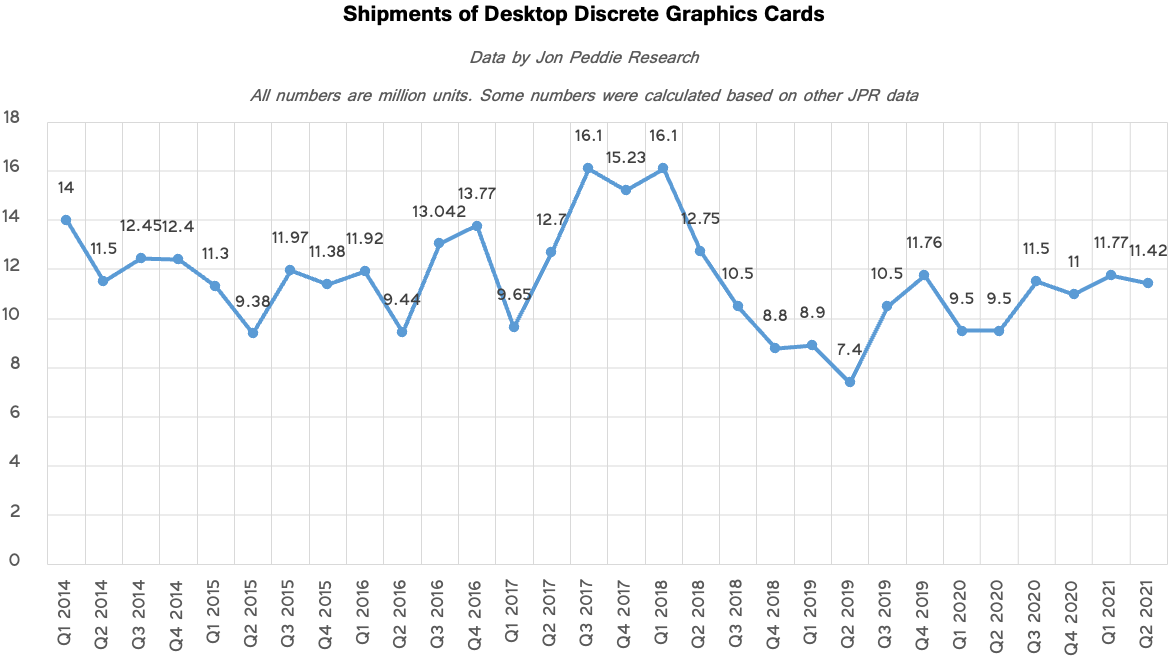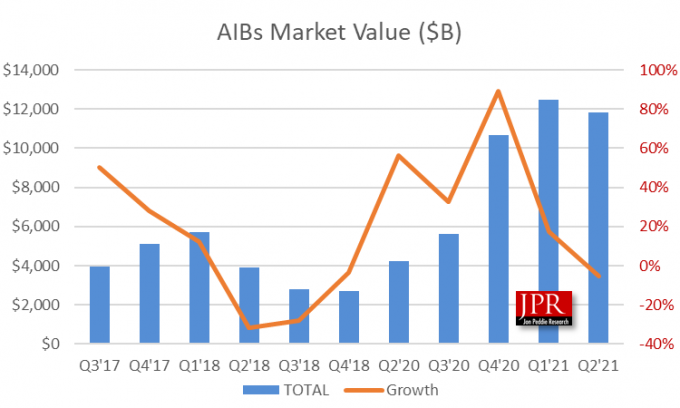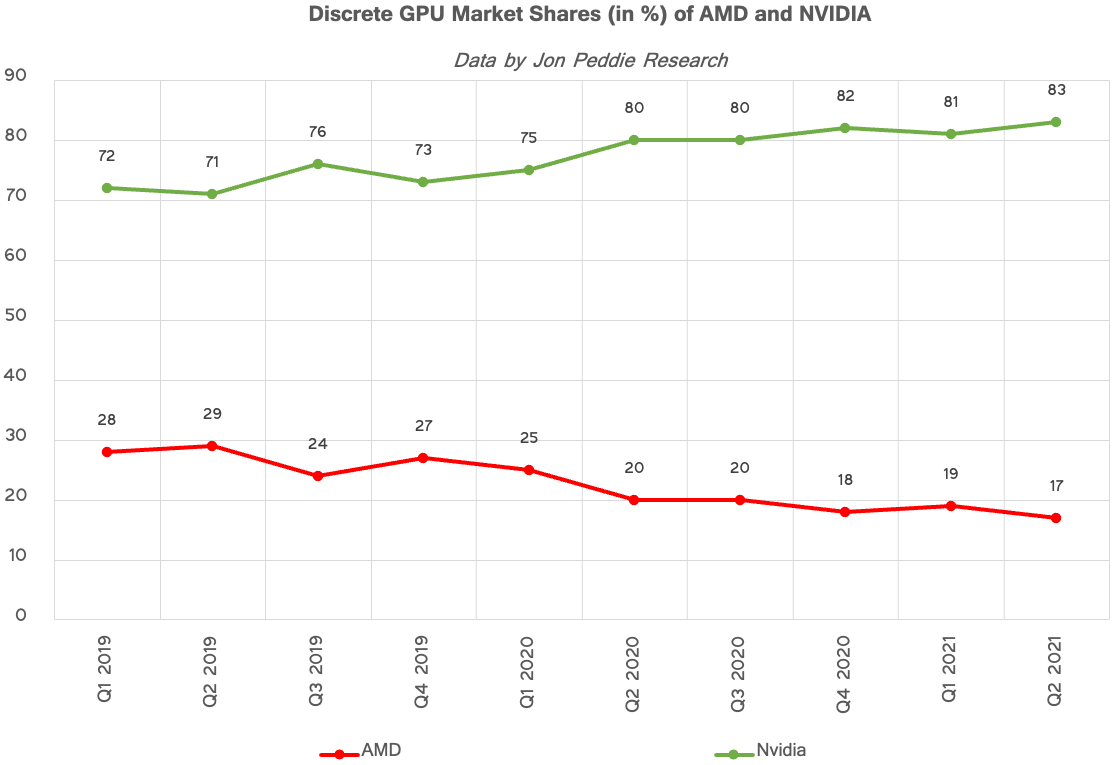Graphics Cards Shipments Decline Slightly but With Record Average Prices
Sales of graphics cards for desktops hit 11.42 million in Q2 2021.
Shipments of standalone graphics cards for desktop PCs in the second quarter 2021 decreased 2.9% compared to the previous quarter, according to data from Jon Peddie Research (JPR). But while graphics boards units sold decreased last quarter, their average selling prices remained at record high levels. Market shares of AMD and Nvidia did not change significantly in Q2 2021, but AMD has hit a multi-year low in discrete GPU shipments.
Shipments of Graphics Cards Down to 11.42 Million
The industry shipped 11.42 million discrete graphics cards for desktop PCs in Q2 2021 (down from 11.77 million in Q1 2021), a decrease of 2.9% quarter-over-quarter (QoQ), but an increase of 20% year-over-year (YoY), according to a JPR report. 11.77 million is more add-in-boards (AIB) than there were sold in Q2 2020, Q2 2019, Q2 2016, and Q2 2015, thus demand for standalone graphics cards in the second quarter was clearly higher than usual.
The second quarter is typically the worst quarter of the year as far as unit shipments of graphics cards are concerned, but this year sales of AIBs were down only slightly in Q2 compared to Q1, a clear indicator that demand for discrete graphics was and remains strong.
Since cryptocurrency prices were not at their highest levels in Q2, demand for discrete desktop boards among miners was not as big of a factor. Meanwhile, gamers still wanted the best graphics cards and were willing to pay rather hefty sums for them. Nvidia also began shipping the RTX 3080 Ti and RTX 3070 Ti, with the former sold at significantly higher prices than the regular RTX 3080.
GPU Prices Remain at Record Levels, Revenue Up 179%
As unit shipments of discrete graphics cards for desktop PCs were down 350 thousand units to 11.42 million in Q2 2021, revenue that various makers received from sales of graphics cards totaled $1.8 billion, a decrease from $12.5 billion in the first quarter, but a whopping increase of 179% year-over-year.
While sales of graphics cards declined a bit in the second quarter, average selling prices (ASPs) of graphics boards remained at slightly over $1,000 per unit, which is a historical record. What's not entirely clear is whether unit sales decreased due to lower demand, or if AMD and Nvidia simply couldn't produce any more cards, but we suspect it's the latter.
In the second quarter, Nvidia released multiple professional graphics cards and reported a record $519 million ProViz revenue. Graphics boards for workstations had an ASP of around $2,150 in the first quarter, and since new ProViz products were launched in April and May, average prices probably got slightly higher in the second quarter as new products tend to be sold at MSRPs, not below them.
Get Tom's Hardware's best news and in-depth reviews, straight to your inbox.
Nvidia Retains Discrete Graphics Crown
After Nvidia lost some share in the first quarter (possibly because AMD was ramping up production of its Radeon RX 6800/6900-series boards), it regained it in the second and now commands 80% shipments of desktop discrete graphics cards. Meanwhile, AMD's share declined to 20%.
In the second quarter Nvidia supplied 9.14 million standalone GPUs for desktop PCs, up from 7.41 million in Q2 2020. AMD shipped 2.28 million discrete desktop GPUs in the second quarter, up from 2.09 million in Q2 2020.
As far as overall discrete GPU shipments (both for desktops and for laptops) are concerned, Nvidia was also leading the pack with an 83% market share in the second quarter, whereas AMD had a 17% share, its lowest in years.
AMD has been bleeding discrete GPU share for quite a while as Nvidia has been very aggressively investing in discrete laptop GPUs and offering tens of SKUs with different configurations and TGP levels. The green company began to ramp up its discrete GeForce RTX 30-series GPUs for laptops in the first quarter, and in Q1 dozens of notebooks with Ampere-based graphics processors inside were on the market.
With competitive desktop and laptop GPUs available to PC makers and retailers, it's not surprising that Nvidia increased its share on the discrete GPU market.
Summary
Demand for discrete desktop graphics cards remains very strong even though the Ethereum mining frenzy was winding down in Q2 due to lowering profitability. Average selling prices of standalone graphics adapters for desktops also remained at record-high levels of around $1,000 per unit in the second quarter, which is why both AMD and Nvidia reported strong results for their most recent quarters.
Nvidia managed to strengthen its positions both in the market of discrete desktop GPUs and in the market of standalone laptop graphics processors in the second quarter. By contrast, AMD lost some share on the desktop and some more on the laptop side of things.

Anton Shilov is a contributing writer at Tom’s Hardware. Over the past couple of decades, he has covered everything from CPUs and GPUs to supercomputers and from modern process technologies and latest fab tools to high-tech industry trends.
-
2Be_or_Not2Be I'm ready to see what the results might be in Q1 '22 if Ethereum does change to a "Proof of Stake" model at the end of the year. I'm not expecting anything good, but it will be interesting to see.Reply
I'm also wondering if Nvidia/AMD are stockpiling a very small bit more for EOY shopping. Not for the benefit of parents/gamers, but more for just the optics later. "Oh, we shipped 2M more GPUs in Nov/Dec - we did everything we could to get a GPU into your hands!" (ignore our record-profits sales in other channels that we don't heavily publicize)




